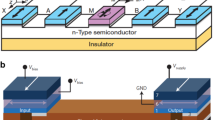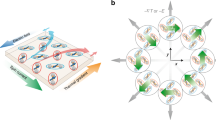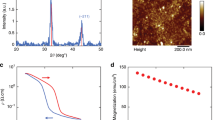Abstract
Spintronics has shown a remarkable and rapid development, for example from the initial discovery of giant magnetoresistance in spin valves1 to their ubiquity in hard-disk read heads in a relatively short time. However, the ability to fully harness electron spin as another degree of freedom in semiconductor devices has been slower to take off. One future avenue that may expand the spintronic technology base is to take advantage of the flexibility intrinsic to organic semiconductors (OSCs), where it is possible to engineer and control their electronic properties and tailor them to obtain new device concepts2. Here we show that we can control the spin polarization of extracted charge carriers from an OSC by the inclusion of a thin interfacial layer of polar material. The electric dipole moment brought about by this layer shifts the OSC highest occupied molecular orbital with respect to the Fermi energy of the ferromagnetic contact. This approach allows us full control of the spin band appropriate for charge-carrier extraction, opening up new spintronic device concepts for future exploitation.
This is a preview of subscription content, access via your institution
Access options
Subscribe to this journal
Receive 12 print issues and online access
$259.00 per year
only $21.58 per issue
Buy this article
- Purchase on Springer Link
- Instant access to full article PDF
Prices may be subject to local taxes which are calculated during checkout




Similar content being viewed by others
Change history
18 January 2011
In the version of this Letter originally published, in the paragraph above the Methods section, 'kiloteslas' should have read 'kBT'. This has been corrected in the HTML and PDF versions.
References
Baibich, M. N. et al. Giant magnetoresistance of (001)Fe/(001)Cr magnetic superlattices. Phys. Rev. Lett. 61, 2472–2475 (1988).
Bergenti, I. et al. Spin polarised electrodes for organic light emitting diodes. Org. Electron. 5, 309–314 (2004).
Salis, G., Alvarado, S. F., Tschudy, M., Brunschwiler, T. & Allenspach, R. Hysteretic electroluminescence in organic light-emitting diodes for spin injection. Phys. Rev. B 70, 085203 (2004).
Xiong, Z. H., Wu, D., Vardeny, Z. & Shi, J. Giant magnetoresistance in organic spin-valves. Nature 427, 821–824 (2004).
Dediu, V. A., Hueso, L. E., Bergenti, I. & Taliani, C. Spin routes in organic semiconductors. Nature Mater. 8, 707–716 (2009).
Lin, R., Wang, F., Rybicki, J., Wohlgenannt, M. & Hutchinson, K. A. Distinguishing between tunnelling and injection regimes of ferromagnet/organic semiconductor/ferromagnet junctions. Phys. Rev. B 81, 195214 (2010).
Jiang, S. B., Pearson, J. E. & Bader, S. D. Absence of spin transport in the organic semiconductor Alq(3). Phys. Rev. B 77, 035303 (2008).
Schoonas, J. J. H. M. et al. Magnetoresistance in hybrid organic spin valves at the onset of multiple-step tunnelling. Phys. Rev. Lett. 103, 146601 (2009).
Sun, D. L. et al. Giant magnetoresistance in organic spin valves. Phys. Rev. Lett. 104, 236602 (2010).
Dediu, V. et al. Room-temperature spintronic effects in Alq3-based hybrid devices. Phys. Rev. B 78, 115203 (2008).
Barraud, C. et al. Unravelling the role of the interface for spin injection into organic semiconductors. Nature Phys. 6, 615–620 (2010).
Cinchetti, M. et al. Determination of spin injection and transport in a ferromagnet/organic semiconductor heterojunction by two-photon photoemission. Nature Mater. 8, 115–119 (2009).
Atodiresei, N. et al. Design of the local spin polarization at the organic–ferromagnetic interface. Phys. Rev. Lett. 105, 066601 (2010).
Campbell, I. H. et al. Controlling charge injection in organic electronic devices using self-assembled monolayers. Appl. Phys. Lett. 71, 3528–3530 (1997).
Bolink, H. J. et al. Molecular ionic junction for enhanced electronic charge transfer. Langmuir 25, 79–83 (2009).
Drew, A. J. et al. Direct measurement of the electronic spin diffusion length in a fully functional organic spin valve by low-energy muon spin rotation. Nature Mater. 8, 109–114 (2009).
Morenzoni, E. et al. Generation of very slow polarized positive muons. Phys. Rev. Lett. 72, 2793–2796 (1994).
Ishi, H. et al. Energy-level alignment at model interfaces of organic electroluminescent devices studied by UV photoemission: Trend in the deviation from the traditional way of estimating the interfacial electronic structures. IEEE J. Sel. Top. Quantum Electron. 2, 24–33 (1998).
Shii, H. & Seki, K. Energy level alignment at organic/metal interfaces studied by UV photoemission: Breakdown of traditional assumption of a common vacuum level at the interface. IEEE Trans. Electron Devices 44, 1295–1301 (1997).
Wang, F. J., Yang, C. G., Vardeny, Z. & Li, X. Spin response in organic spin valves based on La2/3Sr1/3MnO3 electrodes. Phys. Rev. B 75, 245324 (2007).
Wang, F. J. & Vardeny, Z. V. Recent advances in organic spin-valve devices. Synth. Met. 160, 210–215 (2010).
Majumdar, S., Majumdar, H. S., Laiho, R. & Osterbacka, R. Comparing small molecules and polymer for future organic spin-valves. J. Alloys Compd. 423, 169–171 (2006).
Zhan, Y., Bergenti, I., Hueso, L. E. & Dediu, V. Alignment of energy levels at the Alq3/La0.7Sr0.3MnO3 interface for organic spintronic devices. Phys. Rev. B 76, 045406 (2007).
Zhan, Y. Q. et al. Energy level alignment and chemical interaction at Alq3/Co interfaces for organic spintronic devices. Phys. Rev. B 78, 045208 (2008).
Zhan, Y. Q. et al. The role of aluminium oxide buffer layer in organic spin-valves performance. Appl. Phys. Lett. 94, 053301 (2009).
Tiba, M. V., de Jonge, W. J. M., Koopmans, B. & Jonkman, H. T. Morphology and electronic properties of the pentacene on cobalt interface. J. Appl. Phys. 100, 093707 (2006).
Popinciuc, M., Jonkman, H. T. & van Wees, B. J. Energy level alignment symmetry at Co/pentacene/Co interfaces. J. Appl. Phys. 100, 093714 (2006).
Grobosch, M., Dorr, K., Gangineni, R. B. & Knupfer, M. Energy level alignment and injection barriers at spin injection contacts between La0.7Sr0.3MnO3 and organic semiconductors. Appl. Phys. Lett. 92, 023302 (2008).
Lide, D. R. (ed.) Handbook of Physics and Chemistry 90th edn (CRC Press, 2009).
Morley, N. A. et al. Room temperature organic spintronics. J. Appl. Phys. 103, 07F306 (2008).
Smith, D. L. & Ruden, P. P. Spin-polarized tunnelling through potential barriers at ferromagnetic metal/semiconductor Schottky contacts. Phys. Rev. B 78, 125202 (2008).
Valenzuela, S. O., Monsma, D. J., Marcus, C. M., Narayanamurti, V. & Tinkham, M. Spin polarized tunneling at finite bias. Phys. Rev. Lett. 94, 196601 (2005).
Morenzoni, E. et al. Implantation studies of keV positive muons in thin metallic layers. Nucl. Instrum. Methods B 192, 254–266 (2002).
Prokscha, T. et al. The new μE4 beam at PSI: A hybrid-type large acceptance channel for the generation of a high intensity surface-muon beam. Nucl. Instrum. Methods A 595, 317–331 (2008).
Acknowledgements
A.J.D. acknowledges financial support from the Royal Society, Leverhulme Trust and the EPSRC (grant EP/G054568/1), C.B. from the SNF (grant 200020-119784 and 200020-129484) and the NCCR program MaNEP and N.A.M. from the British Council. This experimental work was partly carried out at the Swiss Muon Source SμS.
Author information
Authors and Affiliations
Contributions
A.J.D. was responsible for project planning and concept. L.S., L.N., M.W., V.K.M., C.B., F.L.P., N.A.M., A.S., G.J.N., T.P., E.M. and A.J.D. were responsible for the experimental measurements. L.S., L.N., W.P.G. and A.J.D. were responsible for the analysis and interpretation of results. P.D., P.S., T.K., W.P.G. and A.J.D. were responsible for the sample growth and characterization.
Corresponding authors
Ethics declarations
Competing interests
The authors declare no competing financial interests.
Rights and permissions
About this article
Cite this article
Schulz, L., Nuccio, L., Willis, M. et al. Engineering spin propagation across a hybrid organic/inorganic interface using a polar layer. Nature Mater 10, 39–44 (2011). https://doi.org/10.1038/nmat2912
Received:
Accepted:
Published:
Issue Date:
DOI: https://doi.org/10.1038/nmat2912
This article is cited by
-
Molecular design for enhanced spin transport in molecular semiconductors
Nano Research (2023)
-
Cornerstone of molecular spintronics: Strategies for reliable organic spin valves
Nano Research (2021)
-
Achieving large and nonvolatile tunable magnetoresistance in organic spin valves using electronic phase separated manganites
Nature Communications (2019)
-
Functional Nano-Coating Materials by Michael Addition and Ring-opening Polymerization: Reactivity, Molecular Architecture and Refractive index
Scientific Reports (2018)
-
A segmented conical electric lens for optimization of the beam spot of the low-energy muon facility at PSI: a Geant4 simulation analysis
Nuclear Science and Techniques (2017)



